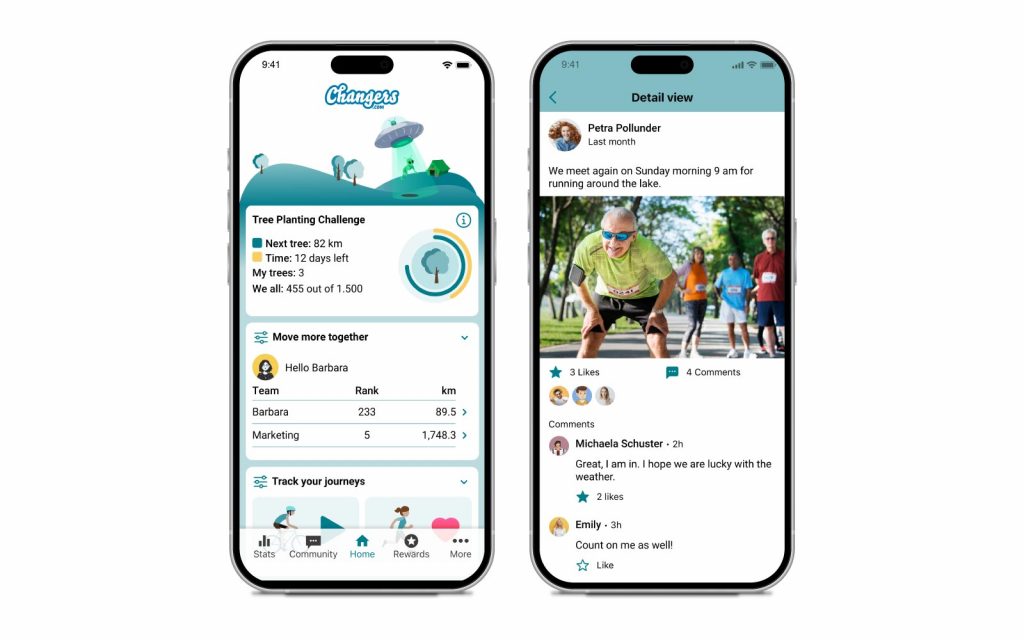
An effective corporate wellness program that is tangible for your employees requires targeted wellness activities that are implemented within the company. But what options are available? How do you identify the right corporate wellness activities for health promotion in your organization? We provide you with a comprehensive overview of relevant measures, innovative concepts, and proven success strategies.
What are Corporate Wellness Activities?
Corporate wellness encompasses a variety of measures aimed at promoting and maintaining the health and well-being of employees in the workplace. These measures are not only focused on minimizing work-related health risks. Rather, they aim to design working conditions to support the physical and psychological health of the workforce.
Possible Prevention Measures at a Glance:
| Category | Behavior-oriented Measures | Environment-oriented Measures |
|---|---|---|
| Nutrition | Nutrition courses, Nutrition counseling | Healthy cafeteria food |
| Movement/Ergonomics | Back courses, Walking | Health-promoting workplace design |
| Stress Management | Courses on relaxation, Stress management, Further education | Health-promoting workplace design |
| Addiction Prevention | Courses on quitting smoking | Smoke-free operation, Improving the workplace climate (Anti-bullying, Leadership) |
| Organizational Design | Advanced training in organization and health | Establishing health circles, Structural measures for health promotion |
| Work Design | Advanced training in work design | Job rotation, Flexible working hours |
| Corporate Culture | Leadership training | Leadership development, Transparent communication, Leadership skills |
Corporate wellness activities can be very diverse, ranging from improving ergonomic equipment to promoting sports and exercise, and offering mental health support. They aim to create a health-promoting work environment where employees feel comfortable, can fully realize their potential, and remain healthy in the long term. By investing in the well-being of their employees, companies not only contribute to individual health but also enhance productivity, employee retention, and ultimately, business success.
Goals of Corporate Wellness Activities
The main goals of corporate wellness management include maintaining and promoting the physical and psychological health of the workforce. This involves minimizing risk factors while enhancing aspects of health promotion to create a work environment where employees can develop, feel comfortable, and work effectively. Through targeted corporate wellness activities, employees gain access to resources that enhance their well-being and reduce work-related stresses, benefiting not only the individual but the entire organization.
Corporate Wellness in Three Central Areas:
| Occupational and Health Protection | Company Reintegration Management | Corporate Health Promotion |
|---|---|---|
| Prevention: healthy and safe work | Service agreement | Exercise |
| Risk assessment | Initial and follow-up discussions | Nutrition |
| Workplace inspections | Health skills | |
| Occupational medical care | Stress management | |
| Training / Instruction | Conflict management | |
| Continuing education | ||
| Healthy leadership |
Corporate wellness measures in corporate wellness management that target corporate culture and the behavior of leaders ensure that health-promoting behavior becomes an integral part of the entire organization. The exemplary role of leaders is crucial as they directly influence daily work processes, self-efficacy, and employee motivation. Therefore, it is essential not only to raise awareness among leaders about health promotion but also to train them to foster a health-conscious leadership and corporate culture.

Further Training for Leaders
Training leaders in areas such as emotional intelligence and compassionate leadership is crucial for promoting a healthy corporate culture.
Cultivating an Effective Feedback Culture
A strong feedback culture enhances mental well-being. Leaders should actively seek and provide feedback to improve exchange within the company.
Strengthening Corporate Communication and Recognizing Employee Performance
Effective communication is crucial for employees to understand their contribution to business success. If there is room for improvement in transparent communication, leaders and employees should jointly optimize communication strategies. The application of management methods like OKRs helps align employee activities with corporate goals, making the value of their work visible.
Encouraging Recognition and Gratitude in the Company
Promoting mutual appreciation and gratitude significantly contributes to increased productivity, work quality, and employee loyalty. As Chester Elton points out in “Leading with Gratitude,” it is crucial for such values to be demonstrated by management. Simple gestures like a sincere thank you or creative approaches like digital kudo cards and expressing gratitude in meetings can strengthen the culture of recognition in companies.
Prioritizing Health at Work Instead of Encouraging Presenteeism
An AOK study found that 70% of respondents go to work sick, which is neither beneficial for themselves nor for the team or company productivity. Companies should encourage employees to make health-conscious decisions and provide resources to prevent physical and mental stress. Promoting health awareness can reduce presenteeism and contribute to the overall improvement of well-being.
Encouraging Recovery Phases
The importance of designated break and vacation times for health is undeniable. Organizations must create an environment where employees can take their breaks without feeling guilty to fully recover.
Allowing Unavailability
A study shows that employees are often expected to be available outside of work hours, leading to stress. Teams should establish clear rules on availability to effectively separate leisure and work.
Investing in Employee Development
Continuing education is a crucial factor for job satisfaction, especially among young employees. Companies should offer individual support for personal development, leading to increased performance and loyalty.
Initiatives for Female Empowerment
Programs that support female empowerment contribute to equality and well-being and can be supported through internal or external networks.
Strengthening Team Spirit Through Joint Activities

Joint activities for a good cause, such as the World Clean Up Day or a company run, strengthen team cohesion. At the same time, social engagement can be promoted by linking achieved performances with the financing of a social project.
A Team Challenge is a Good Opportunity
Team building and employee motivation can be playfully strengthened through a team challenge. A community wall in the app allows employees to exchange ideas in the team, for example, to arrange running meetings or to share progress and achievements.
Proactive Bullying Prevention
Actively raising awareness about bullying and informing employees about support services promotes a positive work environment.
Intensifying Diversity and Inclusion
Linking diversity and health initiatives can increase employee retention and satisfaction. Measures like DEI policies and unconscious bias training are effective.
20 Corporate Wellness Measures for Occupational Health and Safety (OHS)

Occupational health and safety in the company is an essential area that aims to ensure the safety and health of employees at the workplace. Through preventive measures, risk analyses, and the creation of safe working conditions, the well-being of the workforce is promoted, and work accidents as well as occupational diseases are prevented. OHS is legally regulated and requires active implementation and continuous review by employers to guarantee a healthy work environment.
Implementation and Measures in Occupational Health and Safety
Basic Safety Measures
- Regular safety training: Ensuring that all employees are trained in workplace safety.
- Ergonomic workplace design: Adjusting workplaces to prevent posture damage and repetitive strain injuries.
- Protective clothing and equipment: Providing appropriate personal protective equipment, if necessary.
- Emergency plans: Developing and communicating clear emergency plans and procedures.
Health Promotion and Prevention
- Health checks: Regular health checks for employees.
- Mental health resources: Providing support for mental health.
- Prevention courses: Courses to prevent occupational diseases and promote a healthy lifestyle.
- Stress management programs: Programs for stress management and mental health promotion.
Work Environment and Climate
- Noise reduction: Measures to minimize noise at the workplace.
- Air quality management: Measures to ensure good indoor air quality.
- Hazardous substance management: Effective management of hazardous substances.
- Green spaces and relaxation zones: Providing green spaces or rest areas for recovery.
Leadership and Organization
- Health-conscious leadership: Training leaders in health-conscious employee management.
- Evaluation and improvement: Regular reviews and continuous improvements of safety and health measures.
- Health management training: Training employees on health risks and preventive measures.
- Consideration of work psychology: Integrating work psychological aspects into the work process design.
Communication and Engagement
- Employee surveys: Conducting surveys to identify health risks and improve the work environment.
- Crisis intervention plans: Developing plans for handling crisis situations at the workplace.
- Regular breaks: Promoting regular breaks to prevent overstrain and increase concentration.
- Traffic safety programs: Programs to promote traffic safety for employees who travel a lot for work.
15 Corporate Wellness Measures for Workplace Reintegration Management (WRM)

Workplace reintegration management (WRM) is a proactive process in companies aimed at facilitating the return to work for employees after prolonged illness or with health restrictions. WRM includes measures to analyze, design, and adjust working conditions to consider the individual needs of those affected, promote their health, and maintain or restore their working ability. This approach is not only legally required but also an important part of the employer’s duty of care.
Initial Phase and Planning
- Conduct initial talks: Conducting initial talks with affected employees to assess their individual needs and opportunities for reintegration.
- Develop a reintegration plan: Creating an individual reintegration plan that outlines the necessary steps and measures for reintegration.
Workplace Adjustment
- Adjust the workplace: Modifications at the workplace or adjustment of working hours to facilitate the return.
- Enable gradual reintegration: Introducing a gradual return to full workloads to ease the transition.
Health Promotion and Support
- Integrate health-promoting measures: Integrating offerings that support recovery, such as physiotherapy or ergonomic aids.
- Cooperate with medical services: Collaborating with medical professionals to optimally support during the reintegration process.
- Provide aftercare offers: Ensuring long-term support and sustainability of reintegration through aftercare offers.
Education and Psychological Support
- Train leaders: Sensitizing and training supervisors in dealing with re-integrating employees.
- Offer further training and retraining opportunities: Providing opportunities for further training or retraining, if necessary.
- Offer psychological support: Providing support to promote mental health during the reintegration process.
Communication and Flexible Work Design
- Internal communication: Establishing clear communication strategies to minimize uncertainties and create transparency.
- Offer flexible work models: Implementing part-time or home office options to allow a better balance between work and health.
- Actively involve employees: Integrating the ideas and wishes of employees in the design process of the reintegration plan.
Structuring and Monitoring
- Regular monitoring: Continuous review and adjustment of the reintegration process to the needs and progress of the employee.
- Establish a WRM team: Setting up a team or appointing a coordinator to monitor the process and serve as a central contact.
30 Corporate Wellness Measures for Workplace Health Promotion (WHP)

Our individual behavior plays a crucial role in our physical and mental health. Corporate wellness management measures (CWM) provide significant support by encouraging employees to develop health-related resources and proactively improve their own health. These initiatives, which are summarized under workplace health promotion (WHP), aim to comprehensively strengthen physical and mental health, with a special focus on exercise, nutrition, and mental well-being.
Health Promotion and Prevention Programs
- Health days: Workshops on nutrition, exercise, and stress management
- Health check-ups: Preventive examinations at the workplace
- Smoking cessation programs: Support for a smoke-free work environment
- Non-smoker programs: Support and resources for employees
- Blood donation actions and screenings: Regular health days
Nutrition and Healthy Eating
- Nutritional counseling: Healthy eating in the cafeteria
- Cooking competitions and workshops: Raising awareness of healthy eating
Physical Activity and Sports
- Sports programs: Corporate fitness, organized running groups
- Promotion of cycling: Bicycle stands, changing rooms
- Teambuilding activities: Outdoor activities that promote movement
Mental Health and Well-being
- Mental health programs: Workshops on stress management, mindfulness training
- Program to promote mental well-being: Access to counseling services
- Workshops on digital detox: Awareness of the impact of digital media
Relaxation and Rest
- Rest rooms and relaxation zones: Setting up rest rooms for meditation
- Break activities: Stretching, short relaxation exercises
- Massage or physiotherapy offers: Provision in the office
Work-Life Balance and Flexible Work Design
- Work-life balance programs: Flexible working hours and locations
- “Bring Your Pet to Work” Day: Promoting well-being and stress reduction
Education and Training
- Training in health promotion: Educational offerings
- Workshops on time management and productivity: Stress reduction
- Self-defense courses: More security and self-confidence
Environment and Sustainability
- Environmental health measures: Improved air quality, natural lighting
- “Green Team”: Promoting sustainability and improving the work environment
Social Engagement and Cultural Exchange
- Community service activities: Promoting community and health
- Cultural activities: Mental relaxation and cultural exchange
- Volunteer work: Boosting personal well-being
Additional Health Resources
- Health ambassadors or wellness committee: Leading health initiatives
- Partnerships with gyms: Discounted conditions
- Bicycle financing programs or subsidies for public transport


